Ancient Egyptian mythology is a rich tapestry of gods‚ goddesses‚ and supernatural beings‚ explored in depth in “The Complete Gods and Goddesses of Ancient Egypt” by Richard H. Wilkinson. This comprehensive resource delves into the intricate beliefs‚ rituals‚ and symbolism surrounding Egyptian deities‚ offering insights into their roles in shaping the culture‚ religion‚ and daily life of ancient Egyptians. The book provides a detailed examination of both major and minor deities‚ highlighting their significance and the evolution of their worship over time‚ making it an essential guide for understanding Egyptian mythology.
1.1 The Significance of Gods and Goddesses in Ancient Egyptian Culture
In Ancient Egyptian culture‚ gods and goddesses were central to religious‚ social‚ and political life. They embodied natural phenomena‚ moral values‚ and the cosmos‚ influencing every aspect of society. These deities were believed to maintain order (Ma’at) and ensure the fertility of the land. Their significance extended to art‚ literature‚ and daily rituals‚ with temples serving as hubs for worship. The fluidity of their roles and forms allowed them to adapt to changing societal needs. Regional variations in worship further highlighted their importance‚ as local deities often held paramount significance. This divine presence was so integral that it shaped Egypt’s identity and legacy‚ as detailed in resources like “The Complete Gods and Goddesses of Ancient Egypt.”
1.2 The Evolution of Egyptian Mythology Over Time
Egyptian mythology evolved significantly over time‚ adapting to political‚ religious‚ and cultural shifts. Early myths often revolved around local deities tied to natural phenomena. As Egypt unified‚ these myths coalesced into a more cohesive system‚ with gods like Ra and Osiris gaining prominence. Foreign influences‚ such as the Hyksos and Nubians‚ introduced new deities and practices. The New Kingdom saw the rise of Amun and the syncretism of gods like Amun-Ra. Later‚ the influence of Greek and Roman cultures further transformed Egyptian mythology. This dynamic evolution reflects the flexibility and resilience of Egyptian religious thought‚ ensuring its enduring relevance across millennia‚ as explored in “The Complete Gods and Goddesses of Ancient Egypt.”
Major Gods and Goddesses of Ancient Egypt
Ancient Egypt’s pantheon included powerful deities like Ra‚ Isis‚ Osiris‚ and Anubis‚ each embodying natural forces and cultural values. Their roles in creation‚ fertility‚ and the afterlife were central to Egyptian religion and daily life‚ as detailed in “The Complete Gods and Goddesses of Ancient Egypt.”
2.1 Ra: The Sun God and Creator Deity
Ra‚ the sun god‚ was one of ancient Egypt’s most revered deities‚ often depicted with a falcon’s head and a solar disk. As the creator deity‚ Ra was believed to have formed the world and all living beings. His daily journey across the sky symbolized the cyclical nature of time and the pharaohs’ divine legitimacy. In “The Complete Gods and Goddesses of Ancient Egypt‚” Richard H. Wilkinson explores Ra’s central role in Egyptian mythology‚ emphasizing his association with kingship‚ renewal‚ and cosmic order. His worship‚ particularly in Heliopolis‚ underscored his importance as the ultimate source of life and energy‚ making him a cornerstone of Egyptian religious beliefs.
2.2 Isis: The Mother Goddess of Magic and Fertility
Isis‚ the mother goddess of magic and fertility‚ held a universal appeal in ancient Egyptian mythology. As the wife of Osiris and mother of Horus‚ she symbolized maternal devotion and the cyclical renewal of life. In “The Complete Gods and Goddesses of Ancient Egypt‚” Richard H. Wilkinson highlights her role as a protector and healer‚ often invoked in spells and rituals for fertility and childbirth. Isis’s association with magic and her ability to resurrect Osiris cemented her status as a powerful deity. Her influence extended beyond Egypt‚ making her one of the most revered goddesses in the ancient Mediterranean world‚ embodying both nurturing and divine authority.
2.3 Osiris: The God of the Afterlife and Resurrection
Osiris‚ the god of the afterlife and resurrection‚ was a central figure in ancient Egyptian mythology. His myth‚ detailed in “The Complete Gods and Goddesses of Ancient Egypt‚” revolves around his murder by Seth‚ his resurrection by Isis‚ and subsequent role as king of the underworld. As judge of the dead‚ Osiris symbolized eternal life and justice‚ ensuring deceased souls were worthy of paradise. His resurrection mirrored the cyclical flooding of the Nile‚ reinforcing themes of renewal and immortality. This profound narrative made Osiris a beloved deity‚ embodying hope for an afterlife and divine justice‚ and his legacy endured as a cornerstone of Egyptian religious beliefs.
2.4 Anubis: The God of Mummification and the Afterlife
Anubis‚ the god of mummification and the afterlife‚ was a pivotal figure in ancient Egyptian mythology‚ as detailed in “The Complete Gods and Goddesses of Ancient Egypt.” Often depicted as a jackal or a man with a jackal’s head‚ Anubis was associated with embalming‚ protecting the dead‚ and guiding souls through the afterlife. His role involved overseeing the mummification process‚ ensuring the deceased were properly preserved for their journey to the afterlife. Anubis also played a critical role in the “Weighing of the Heart” ceremony‚ where he assisted in determining the worthiness of the soul. His guardianship of tombs and the dead solidified his importance in Egyptian funerary rituals and beliefs about immortality.
2.5 Nephthys: The Goddess of Death and Mourning
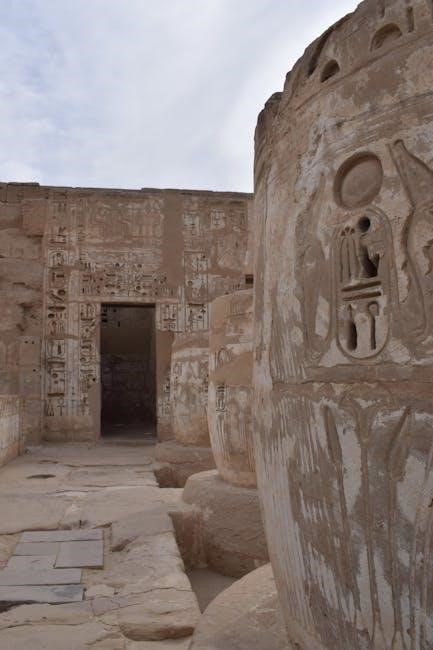
Nephthys‚ the goddess of death and mourning‚ held a significant role in ancient Egyptian mythology‚ as explored in “The Complete Gods and Goddesses of Ancient Egypt.” Often depicted as a woman with the head of a bird of prey‚ she was associated with the night‚ the desert‚ and the pharaohs. Nephthys was the sister of Isis‚ Osiris‚ and Seth‚ and her marriage to Seth further tied her to themes of chaos and the afterlife. She was believed to protect the dead and assist in their transition to the afterlife‚ often appearing in funerary rites to ensure the deceased pharaohs’ safe passage. Her role emphasized the duality of death and rebirth in Egyptian beliefs.
Other Notable Deities
Ancient Egypt’s pantheon includes numerous notable deities like Thoth‚ Horus‚ Seth‚ Nephthys‚ Taweret‚ and Bes‚ each with unique roles in shaping the spiritual and cultural landscape.
3;1 Thoth: The God of Wisdom‚ Writing‚ and Knowledge
Thoth‚ the god of wisdom‚ writing‚ and knowledge‚ was a central figure in Egyptian mythology‚ often depicted as a man with the head of an ibis or baboon. He was revered as the creator of hieroglyphs and the patron of scribes‚ embodying the power of language and intellect. Thoth’s role extended to magic‚ meditation‚ and the moon‚ symbolizing his connection to both the sacred and the mysterious. As a mediator between gods and humans‚ he was often called upon to resolve conflicts and maintain cosmic order. His association with wisdom and knowledge made him indispensable in Egyptian culture‚ where he was celebrated as a divine source of inspiration and enlightenment.
3.2 Horus: The God of Kingship and Protection
Horus‚ the falcon-headed god‚ was a central figure in Egyptian mythology‚ embodying kingship and protection. As the son of Osiris and Isis‚ he was destined to rule‚ symbolizing divine authority and justice. His conflict with Seth‚ representing chaos‚ highlighted his role as a defender of order. Horus was often depicted with the head of a falcon‚ emphasizing his sharp vision and dominion over the skies. Pharaohs claimed descent from Horus‚ reinforcing their legitimacy as rulers. Beyond kingship‚ Horus was revered as a protector of individuals‚ safeguarding life and ensuring harmony. His legacy underscores the enduring importance of protection and rightful governance in ancient Egyptian culture and religion.
3.3 Seth: The God of Chaos and the Desert
Seth‚ often depicted with the head of an unidentified animal‚ was the god of chaos‚ disorder‚ and the desert. As the brother of Osiris and antagonist in the Osiris myth‚ Seth embodied conflict and disruption. His association with the desert and foreign lands symbolized the unknown and the dangerous. Despite his feared reputation‚ Seth also had protective roles‚ such as defending the sun god Ra from the serpent Apep. His complex nature reflected the duality of chaos and order‚ making him a multifaceted figure in Egyptian mythology. Seth’s influence extended beyond Egypt‚ linking him to foreign deities and cultures‚ further highlighting his enigmatic and vital role in ancient Egyptian belief systems.
3.4 Nephthys: The Goddess of Death and Mourning (continued)
Nephthys‚ the goddess of death and mourning‚ played a pivotal role in guiding spirits to the afterlife‚ often depicted in funerary rites. Her association with the night and the shadows underscored her connection to the mysterious and the unknown. As the sister of Isis and wife of Seth‚ Nephthys embodied duality‚ balancing mourning with protection. She was frequently invoked in spells to safeguard the deceased and ensure their safe passage. Her role in Egyptian mythology highlights the intricate interplay between death‚ resurrection‚ and the cosmic order‚ making her a revered yet enigmatic figure in ancient Egyptian religious practices and beliefs.
3.5 Taweret: The Goddess of Pregnancy and Childbirth
Taweret‚ often depicted as a pregnant hippopotamus‚ was the protector of women during pregnancy and childbirth‚ embodying fertility and maternal care. Her unique form symbolized strength and nurturing‚ blending ferocity with gentleness. As a household deity‚ Taweret was invoked to safeguard expectant mothers and newborns from harm‚ reflecting her role in ensuring the continuity of life. Her association with the home and family underscored her importance in domestic rituals‚ making her a cherished figure in ancient Egyptian daily life and religious practices focused on fertility and protection.
3.6 Bes: The God of Protection and Household
Bes‚ often depicted as a dwarf with a large head‚ was a unique and vital deity in ancient Egyptian mythology. Unlike other gods‚ Bes was not associated with grand cosmic roles but instead focused on protecting the household‚ children‚ and the intimate aspects of daily life. His ferocious appearance‚ which included a protruding tongue and lion-like features‚ symbolized his role in warding off evil spirits and misfortune. Bes was also linked to music‚ dance‚ and fertility‚ making him a beloved figure in domestic rituals. His worship was deeply personal‚ with individuals often invoking him for safeguarding their homes and families‚ reflecting his enduring importance as a guardian of everyday life and well-being.
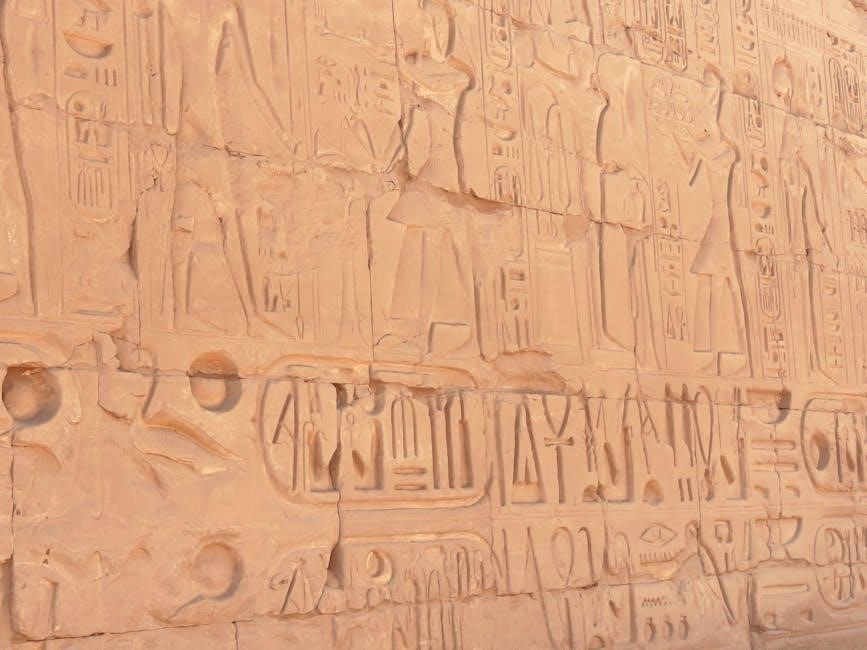
The Role of Minor and Household Gods
Minor and household gods like Bes and Taweret played a crucial role in daily life‚ offering protection and personal spiritual connection to individuals and families.
4.1 Bes: The God of Protection and Household (continued)
Bes‚ a minor yet significant deity‚ was revered for his role in protecting households and individuals from evil spirits and misfortune. Often depicted as a dwarf with a lion-like face‚ Bes was associated with music‚ dance‚ and entertainment‚ embodying the joy and vibrancy of domestic life. His presence was believed to ward off dangers‚ particularly during childbirth and sleep‚ making him a beloved figure in family rituals. Despite his fearsome appearance‚ Bes symbolized the warmth and security of home‚ reflecting the deep connection Egyptians felt with their personal gods. His cult‚ though not widespread‚ held a special place in the hearts of many‚ underscoring the diversity of Egyptian religious practices.
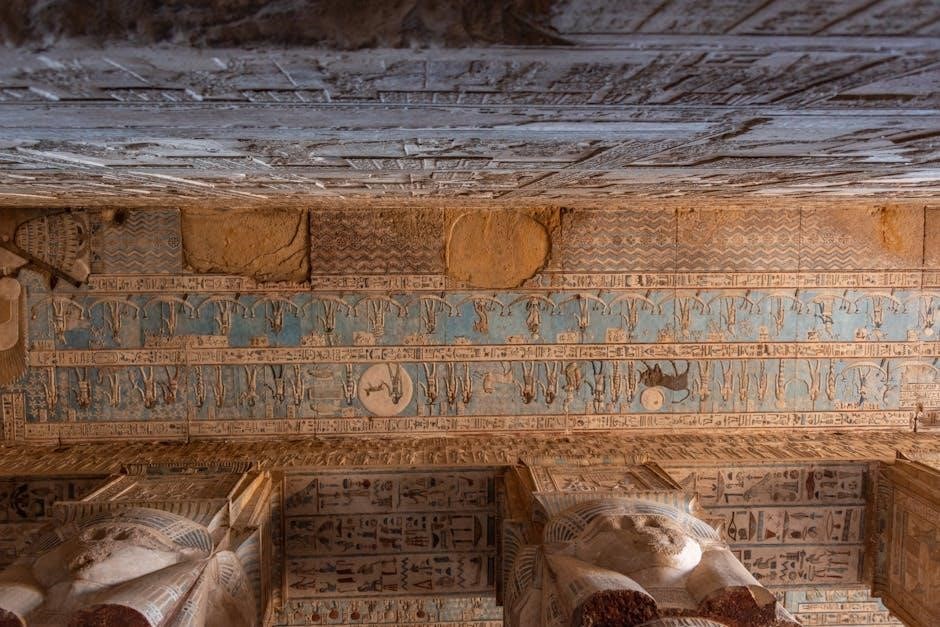
4.2 Taweret: The Goddess of Pregnancy and Childbirth (continued)
Taweret‚ the hippocampus-like goddess‚ played a vital role in safeguarding women during pregnancy and childbirth. Her unique appearance‚ combining a pregnant hippopotamus body with a lioness’s head and human-like features‚ symbolized fertility and protection. As a household deity‚ Taweret was often depicted in amulets and domestic artifacts‚ embodying the fears and hopes of mothers. Her protective powers extended to newborns‚ warding off evil spirits and ensuring their safe passage into life. Taweret’s significance lies in her blend of ferocity and nurturing‚ reflecting the duality of ancient Egyptian beliefs about childbirth. Her cult‚ though localized‚ underscores the importance of maternal health in Egyptian society.
4.3 The Role of Minor Deities in Daily Life
Minor deities like Bes and Taweret played significant roles in daily life‚ offering protection and guidance in personal and household matters. These gods were often invoked in domestic rituals‚ amulets‚ and charms to ensure safety‚ fertility‚ and prosperity. Their influence extended to childbirth‚ home protection‚ and warding off evil spirits‚ making them integral to family life. Unlike major deities‚ minor gods were more approachable‚ bridging the gap between the divine and human spheres. Their roles highlight the Egyptians’ deep connection to religion in everyday activities‚ emphasizing the importance of spirituality in both grand and mundane aspects of life.
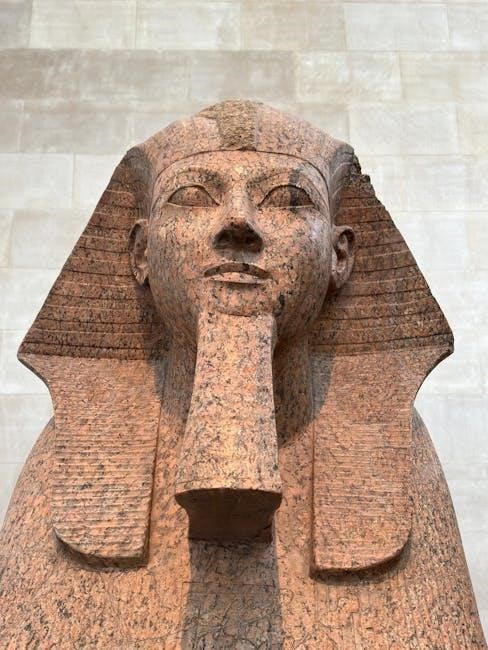
The Fluidity of Egyptian Deities
Egyptian deities exhibited remarkable fluidity‚ blending forms‚ names‚ and roles. Syncretism allowed gods to merge identities‚ creating complex‚ evolving divine figures like Amun-Ra‚ reflecting dynamic religious transformations over time.
5.1 The Concept of Syncretism in Egyptian Mythology
Syncretism in Egyptian mythology refers to the blending of different deities‚ resulting in merged identities. This practice allowed gods to combine attributes‚ creating powerful hybrid figures like Amun-Ra. Such syncretism often occurred to unify religious beliefs across regions‚ as seen in the fusion of Amun of Thebes with Ra of Heliopolis. This process highlighted the fluidity of Egyptian deities‚ enabling their roles to evolve and adapt to changing cultural and political landscapes. Through syncretism‚ Egyptian religion maintained its complexity and richness‚ ensuring the continued relevance of its gods across different eras and geographical areas.
5.2 The Transformation of Gods and Their Roles Over Time
Egyptian gods and goddesses underwent significant transformations as their roles evolved over time. Major deities like Ra and Amun expanded their influence‚ adapting to political and cultural shifts‚ such as the rise of Thebes. Regional worship often elevated local gods to national prominence‚ blending their attributes with existing pantheon figures. Minor deities like Bes and Taweret gained importance in household religion‚ reflecting changes in societal needs. This adaptability ensured Egyptian mythology remained vibrant and relevant‚ with gods continuously reinterpreted to align with the spiritual and political demands of each era‚ showcasing the dynamic nature of ancient Egyptian religious beliefs.
Regional Variations in Worship
Regional worship varied across Egypt‚ with Thebes honoring Amun‚ Heliopolis revering Ra‚ and the Nile Delta emphasizing Isis‚ reflecting diverse religious practices and local influences.
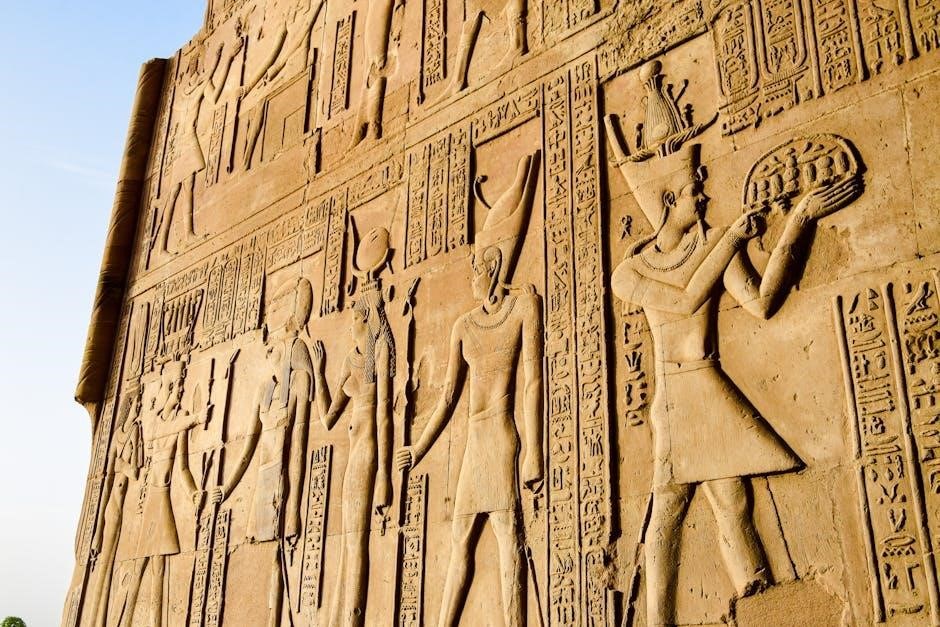
6.1 The Worship of Amun in Thebes
The worship of Amun in Thebes was central to ancient Egyptian religion‚ as highlighted in “The Complete Gods and Goddesses of Ancient Egypt.” Amun‚ often depicted with a ram’s head‚ was revered as a powerful sun god and the king of the gods. His cult in Thebes flourished‚ particularly during the New Kingdom‚ when he became closely associated with the pharaohs‚ who were seen as his earthly manifestations. The grand temples at Karnak and Luxor were dedicated to Amun‚ serving as centers of religious and political power. The annual Opet Festival celebrated Amun’s marriage to Mut‚ showcasing his divine authority and influence over fertility and kingship.
6.2 The Cult of Ra in Heliopolis
Heliopolis‚ the “City of the Sun‚” was the epicenter of Ra’s worship‚ as detailed in “The Complete Gods and Goddesses of Ancient Egypt.” Ra‚ the sun god‚ was revered as the creator and sustainer of life‚ embodying the solar disk. His cult flourished in this sacred city‚ where the obelisk symbolized his connection to the heavens. The priests of Ra performed elaborate rituals to maintain cosmic order‚ ensuring the sun’s daily journey. The worship of Ra in Heliopolis was deeply intertwined with pharaonic legitimacy‚ reinforcing the king’s divine right to rule. This cult played a pivotal role in shaping Egyptian theology and solar symbolism.
6.3 The Significance of Isis in the Nile Delta
Isis‚ the mother goddess of magic and fertility‚ held profound significance in the Nile Delta‚ as explored in “The Complete Gods and Goddesses of Ancient Egypt.” Her cult flourished in this region‚ where she was revered for her protective and nurturing qualities. Isis’s role in safeguarding the pharaohs and ensuring fertility made her a central figure in local worship. Her association with the throne and her magical powers further solidified her importance. The Nile Delta’s strategic location facilitated the spread of her cult‚ blending local traditions with her universal appeal. This region became a hub for Isis’s veneration‚ showcasing her enduring influence in Egyptian religion and beyond.
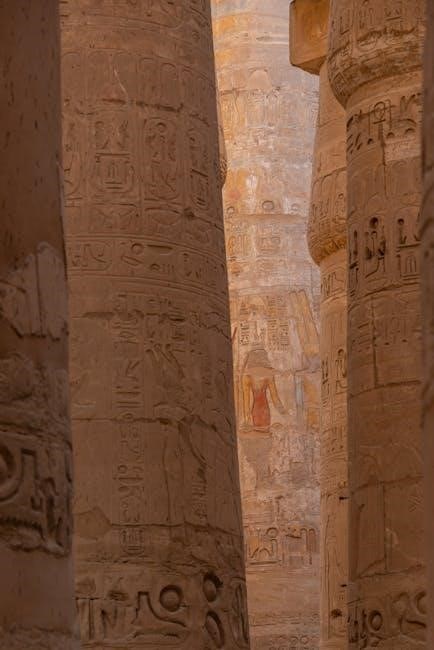
The Relationship Between Gods and Humans
In ancient Egypt‚ gods and humans shared a reciprocal relationship‚ with humans offering devotion and gods providing protection and guidance. This dynamic‚ as explored in “The Complete Gods and Goddesses of Ancient Egypt‚” emphasized the importance of maintaining balance through rituals and offerings‚ ensuring harmony between the divine and mortal realms.
7.1 The Concept of the Ka and Ba in Relation to the Gods
The concepts of the Ka and Ba were central to ancient Egyptian spirituality‚ as detailed in “The Complete Gods and Goddesses of Ancient Egypt.” The Ka‚ a vital energy or life force‚ was believed to sustain both gods and humans‚ while the Ba represented the personality or soul. Together‚ they ensured the individual’s continued existence in the afterlife. The gods were seen as the ultimate source of Ka‚ granting it to humans and maintaining the cosmic order. This interconnection emphasized the reciprocal relationship between mortals and deities‚ with offerings and rituals serving to honor and sustain this divine bond.
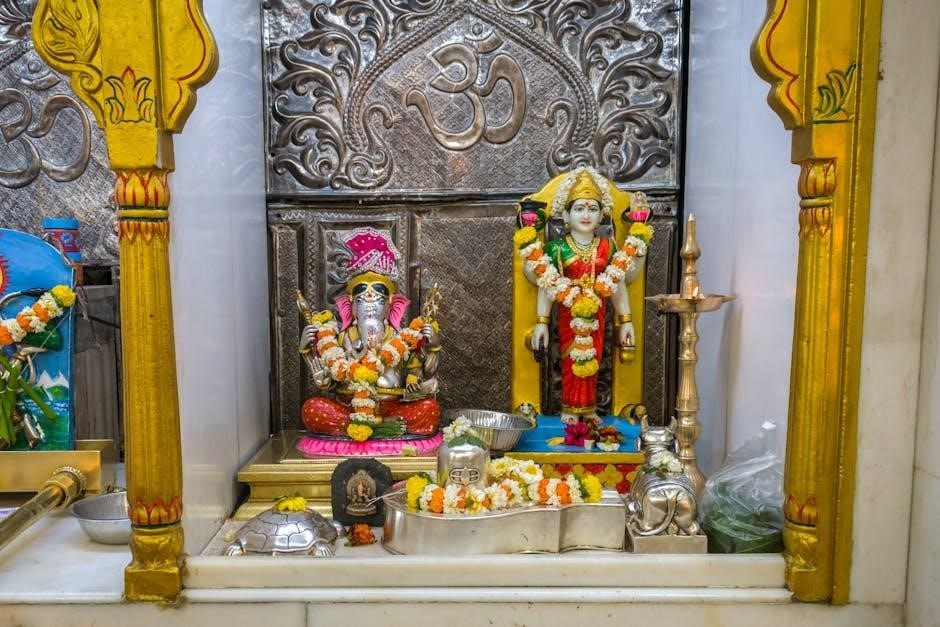
7.2 The Role of Priests as Intermediaries Between Gods and Humans
Priests in ancient Egypt served as vital intermediaries between the gods and humanity‚ playing a central role in religious rituals and daily life. They were responsible for performing sacred ceremonies‚ offering sacrifices‚ and interpreting divine will. Through their knowledge of sacred texts and symbols‚ priests maintained the balance between the mortal and divine realms. Their role was essential for ensuring the gods’ favor and upholding cosmic order. As detailed in “The Complete Gods and Goddesses of Ancient Egypt‚” priests acted as guardians of religious traditions‚ ensuring that the connection between humans and deities remained strong and harmonious. Their influence extended beyond temples‚ shaping societal norms and individual devotion.
The Decline of the Old Religion
The old Egyptian religion gradually declined due to internal shifts in belief and external pressures‚ as documented in Wilkinson’s analysis of the gods’ evolving roles and worship practices.
8.1 The Rise of Monotheistic Religions and Their Impact on Egyptian Mythology
The rise of monotheistic religions‚ such as Christianity and Islam‚ significantly impacted ancient Egyptian mythology. These religions introduced a single‚ all-powerful deity‚ contrasting with Egypt’s polytheistic traditions. As monotheism spread‚ the elaborate pantheon of Egyptian gods and goddesses gradually lost prominence. Temples dedicated to deities like Amun and Isis were closed‚ and their rituals suppressed. The shift in religious beliefs eroded the cultural and spiritual foundation of Egyptian mythology‚ leading to its decline. This transformation‚ as documented in Wilkinson’s analysis‚ marked the end of a millennia-long religious tradition‚ replacing it with new faiths that reshaped the spiritual landscape of the Mediterranean world.
- The introduction of monotheism simplified religious practices.
- Temples were repurposed or abandoned.
- Mythological stories lost their central role in society.
This period marked a profound cultural shift‚ ending the dominance of ancient Egyptian mythology.
8.2 The Suppression of Pagan Worship in the Roman Period
The Roman Period saw significant suppression of pagan worship in Egypt‚ as Roman authorities sought to impose their own religious practices and suppress local traditions. Temples dedicated to Egyptian deities were gradually closed‚ and their rituals were banned. The Roman Empire’s embrace of Christianity further accelerated this decline‚ as pagan practices were labeled heretical. The once-thriving religious centers‚ such as the temple of Isis on Philae‚ were eventually abandoned. This suppression marked the final stages of ancient Egyptian mythology’s decline‚ as the Roman administration systematically dismantled the religious infrastructure that had sustained it for millennia. The cultural and spiritual practices of Egypt were forever altered.
- Temples were closed‚ and rituals were outlawed.
- Christianity’s rise hastened the decline of paganism.
- Egyptian mythology lost its institutional support.
This period marked the end of Egypt’s ancient religious traditions.
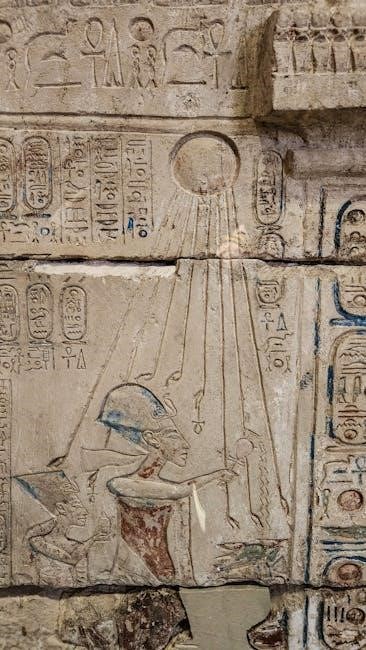
The Legacy of Ancient Egyptian Gods and Goddesses
The legacy of Egyptian deities endures in modern culture‚ art‚ and literature‚ with “The Complete Gods and Goddesses of Ancient Egypt” serving as a timeless resource. Their influence is evident in symbolism‚ storytelling‚ and spiritual practices globally‚ showcasing their lasting impact on human culture and imagination.
- Influence on modern culture and art.
- Continuous study and appreciation today.
- Symbolism in literature and media.
9.1 The Influence of Egyptian Mythology on Modern Culture
Egyptian mythology’s vibrant imagery and timeless themes have profoundly shaped modern culture‚ inspiring art‚ literature‚ and film. The iconic gods and goddesses‚ such as Ra‚ Isis‚ and Anubis‚ appear in movies‚ video games‚ and literature‚ captivating global audiences. Their stories of creation‚ resurrection‚ and cosmic order resonate universally‚ influencing contemporary spirituality and symbolism. “The Complete Gods and Goddesses of Ancient Egypt” by Richard H. Wilkinson highlights this enduring appeal‚ showcasing how ancient myths continue to inspire creativity and thought. Egyptian motifs are also seen in architecture‚ fashion‚ and branding‚ underscoring their lasting legacy in human culture.
- Inspiration in modern media and entertainment.
- Influence on art‚ literature‚ and spirituality.
- Use of Egyptian motifs in design and branding.
9.2 The Continued Study and Appreciation of Egyptian Deities Today
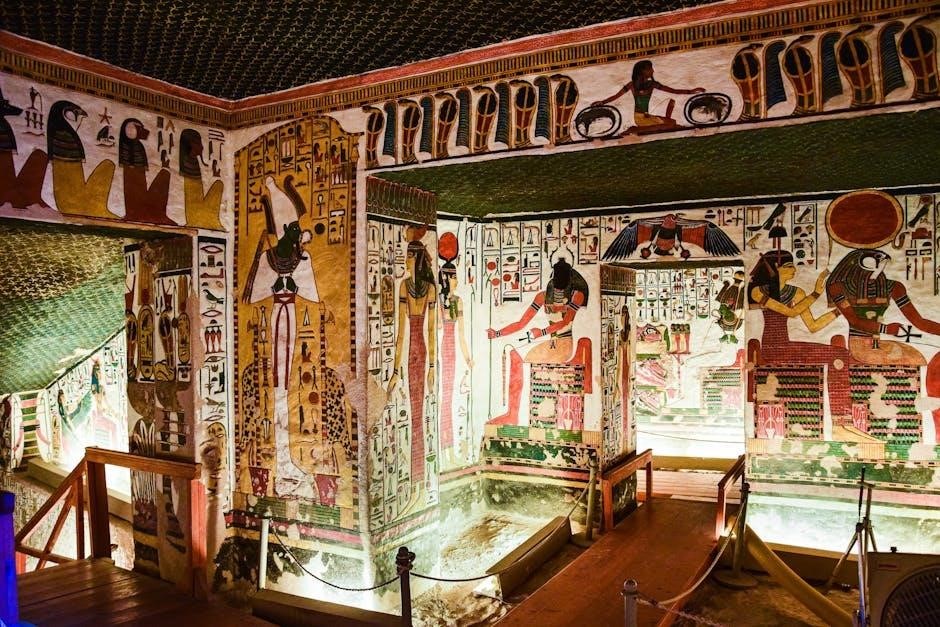
The study of Egyptian deities remains a vibrant field of academic and cultural interest. Scholars and enthusiasts alike continue to explore the roles of gods like Ra‚ Isis‚ and Anubis‚ drawing insights from texts such as “The Complete Gods and Goddesses of Ancient Egypt.” This book‚ by Richard H. Wilkinson‚ provides a detailed analysis of Egyptian mythology‚ making it a valuable resource for both researchers and the general public. Digital platforms and educational programs have further democratized access to these studies‚ fostering a global appreciation for Egypt’s spiritual heritage. This ongoing interest highlights the timeless allure of Egyptian mythology.
- Academic research and cultural fascination with Egyptian deities.
- The role of “The Complete Gods and Goddesses of Ancient Egypt” in modern studies.
- Global accessibility through digital and educational resources.